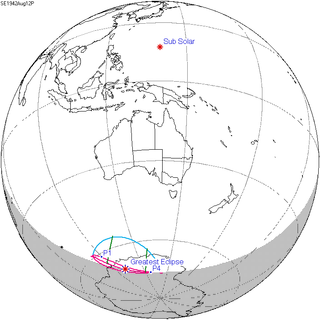
Summary
A partial solar eclipse occurred on Wednesday, August 12, 1942. A solar eclipse occurs when the Moon passes between Earth and the Sun, thereby totally or partly obscuring the image of the Sun for a viewer on Earth. A partial solar eclipse occurs in the polar regions of the Earth when the center of the Moon's shadow misses the Earth. This was the 72nd of 72 solar eclipses in Saros 115 and the final eclipse.
| Solar eclipse of August 12, 1942 | |
|---|---|
 Map | |
| Type of eclipse | |
| Nature | Partial |
| Gamma | −1.5244 |
| Magnitude | 0.0561 |
| Maximum eclipse | |
| Coordinates | 70°24′S 99°54′E / 70.4°S 99.9°E |
| Times (UTC) | |
| Greatest eclipse | 2:45:12 |
| References | |
| Saros | 115 (72 of 72) |
| Catalog # (SE5000) | 9381 |
Related eclipses edit
Solar eclipses 1942–1946 edit
This eclipse is a member of a semester series. An eclipse in a semester series of solar eclipses repeats approximately every 177 days and 4 hours (a semester) at alternating nodes of the Moon's orbit.[1]
Note: The partial solar eclipse on September 10, 1942 occurs in the previous lunar year eclipse set.
| Solar eclipse series sets from 1942 to 1946 | ||||
|---|---|---|---|---|
| Ascending node | Descending node | |||
| 115 | August 12, 1942 Partial |
120 | February 4, 1943 Total | |
| 125 | August 1, 1943 Annular |
130 | January 25, 1944 Total | |
| 135 | July 20, 1944 Annular |
140 | January 14, 1945 Annular | |
| 145 | July 9, 1945 Total |
150 | January 3, 1946 Partial | |
| 155 | June 29, 1946 Partial | |||
Metonic series edit
The metonic series repeats eclipses every 19 years (6939.69 days), lasting about 5 cycles. Eclipses occur in nearly the same calendar date. In addition, the octon subseries repeats 1/5 of that or every 3.8 years (1387.94 days). All eclipses in this table occur at the Moon's ascending node.
| 22 eclipse events between January 5, 1935 and August 11, 2018 | ||||
|---|---|---|---|---|
| January 4-5 | October 23-24 | August 10-12 | May 30-31 | March 18-19 |
| 111 | 113 | 115 | 117 | 119 |
| January 5, 1935 |
August 12, 1942 May 30, 1946 |
March 18, 1950 | ||
| 121 | 123 | 125 | 127 | 129 |
| January 5, 1954 |
October 23, 1957 |
August 11, 1961 |
May 30, 1965 |
March 18, 1969 |
| 131 | 133 | 135 | 137 | 139 |
| January 4, 1973 |
October 23, 1976 |
August 10, 1980 |
May 30, 1984 |
March 18, 1988 |
| 141 | 143 | 145 | 147 | 149 |
| January 4, 1992 |
October 24, 1995 |
August 11, 1999 |
May 31, 2003 |
March 19, 2007 |
| 151 | 153 | 155 | ||
| January 4, 2011 |
October 23, 2014 |
August 11, 2018 |
||
See also edit
References edit
- ^ van Gent, R.H. "Solar- and Lunar-Eclipse Predictions from Antiquity to the Present". A Catalogue of Eclipse Cycles. Utrecht University. Retrieved 6 October 2018.
External links edit
- Earth visibility chart and eclipse statistics Eclipse Predictions by Fred Espenak, NASA/GSFC
- Besselian elements


